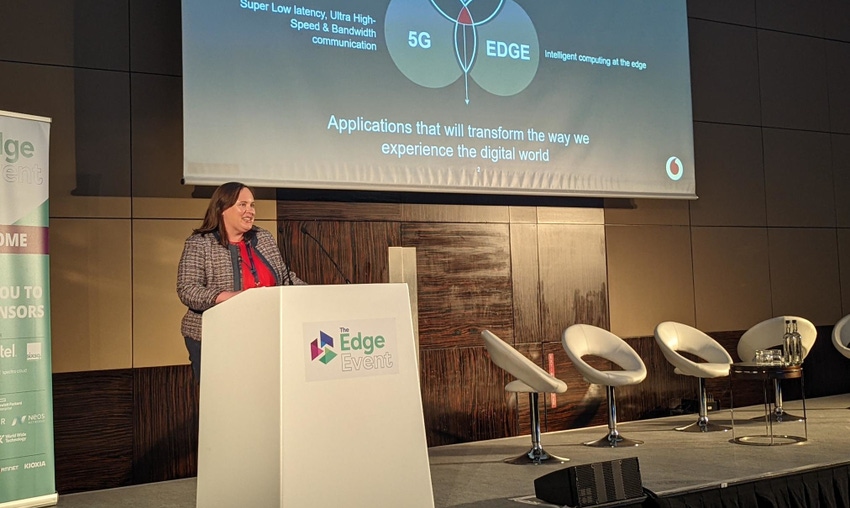Speakers from big tech and the telecoms industry gathered for The Edge Event in London to wax around the potential and also the difficulties involved in the brave new world of edge computing.
June 14, 2022

Speakers from big tech and the telecoms industry gathered for The Edge Event in London to wax around the potential, but also the difficulties involved, in the brave new world of edge computing.
Telco professionals gathered in the Park Plaza by Westminster this morning to talk about edge computing and how it relates to 5G networks, and one thing they all seem to signal is that while using this stuff has all sorts of benefits and may well represent an inevitable future, it’s also an extremely complex commercial ecosystem right now and there are many ways to go at it if you are a business looking to upgrade your operations.
AWS kicked off proceedings asking questions such as what does the rise in edge computing mean for the centralised cloud business model, and waxing on the fact that hyperscalers are expanding their reach outside of the traditional cloud business model by introducing enterprise solutions that sit closer to end users, as well as offering new services that directly integrate with 5G networks. Clearly this dynamic has some ramifications on how hyperscalers interact with telcos.
Intel talked about the growing popularity of private wireless networks, of integrating RAN and core, security, sustainability and a related buzz term ‘continuous accountability’. The chip giant essentially laid out its wares in the space, explaining how its Smart Edge product can enable all sorts of edge and private networks related installations. The key takeaway was the importance of private networks and edge working together in enterprise settings, and some interesting stats were imparted along the way such as that by 2025 the edge computing ‘opportunity’ will be worth $29 billion.
The other impression you got from Intel is that edge computing and private networks is a powerful thing to have, but it’s extremely complex and that’s where it implies it comes in with all sorts of tools such as automation solutions to make things such as data analysis simpler.
Vodafone’s presentation was a pitch for its collaborative approach to providing edge computing and cloud services by working with its hyperscaler partners, as opposed presumably to competing with them. One of the benefits of this, we are told, is that customers don’t necessarily want to belong to just one cloud provider – and this is where telcos can come in and can play a role by working with multiple partners.
‘Use cases at the intersection of edge, 5G, SW defined connectivity and cloud will transform how we all experience the digital world,’ and the edge ‘requires the orchestration of many players’, we were told. Vodafone says it wants to simplify a complex marketplace, by working with various industry players and providing a managed services layer on top additional managed services on top of it all. While that might be true, it should be pointed out that as a telco it could hardly get involved in the edge and cloud space without teaming up with the hyperscalers – so how much this approach is born out of innovation or necessity on their part can be debated.
EDF took to the stage to say they want to invest in R&D for future energy types and that they will use the edge to do this by leveraging low latency of lots of data crunching for drones, smart grid and equipment logistics. You might not necessarily think an energy provider would be massively cutting edge, but EDF has apparently been using embedded AI using edge and 5G installations since 2019 in some form. Lifting safety is listed a key usage, which seems to mean shifting great big lids on power plants. LiDAR plugged into the edge apparently helps with optimising logistics within the innards of plants, and yet more 5G/edge goodness helps them with designing new future installations.
A couple of other themes stand out so far – one was around tempering expectations of 5G as its still a new technology and can’t necessarily perform to the level the more far out use cases suggest – yet. The other was around healthcare, in which we were presented with a future in which edge/5G increasingly play a role in such things as infusion pumps, smart-pharma, tracing and tracking/geo-fencing, and cardiac monitoring. ‘There is no 5g medical device you can buy off the shelf’ we were reminded, however, which is another nod to the idea that while all this stuff can be powerful, right now implementing it isn’t as easy as buying in a new bit of accounting software.
There are plenty more sessions throughout the day investigating the various niches of the sector, but the as many of the speakers are keen to point out, for all its potential edge is a busy marketplace with lots of players and lots of approaches – and now doubt somewhat overwhelming if you run a firm that these services are targeted at but don’t happen to be immersed in the sometimes impenetrable lingo which comes with it.
Get the latest news straight to your inbox. Register for the Telecoms.com newsletter here.
About the Author(s)
You May Also Like








.png?width=300&auto=webp&quality=80&disable=upscale)


_1.jpg?width=300&auto=webp&quality=80&disable=upscale)


.png?width=800&auto=webp&quality=80&disable=upscale)